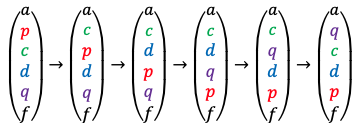The determinant is a number associated with an matrix
. It is defined as
where
-
is an element of in the first row of
.
is the cofactor associated with
.
, the minor of the element
, is the determinant of the
matrix obtained by removing the
row and
-th column of
.
In the case of , we say that the summation is a cofactor expansion along row 1. For example, the determinant of
is
For any square matrix, the cofactor expansion along any row and any column results in the same determinant, i.e.
To prove this, we begin with the proof that the cofactor expansion along any row results in the same determinant, i.e. for
. Consider a matrix
, which is obtained from
by swapping row
consecutively with rows above it
times until it resides in row 1. According to property 8 (see below), we have
According to property 10, and therefore, the cofactor expansion along any column also results in the same determinant. This concludes the proof.
In short, to calculate the determinant of an matrix, we can carry out the cofactor expansion along any row or column. If we expand along a row, we have
. We then select any row
to execute the summation. Conversely, if we expand along a column, we get
.
The following are some useful properties of determinants:
-
, where is
the identity matrix. If one of the diagonal elements of
is
, then
.
- If the elements of one of the columns of
are all zero,
.
- If
is obtained from
by multiplying the
-th row of
by
,
.
- If
is obtained from
by swapping two rows or columns of
, then
- If two rows or two columns of
are the same,
.
- The inverse of a matrix exists only if
.
- If
, then
.
- If
, then
. If
, then
.
- If
is diagonal, then
.
Proof of property 1
We shall proof this property by induction.
For ,
For ,
Let’s assume that for ,
. Then for
,
We can repeat the above induction logic to prove that if one of the diagonal elements of
is
.
Proof of property 2
Again, we shall proof this property by induction.
For ,
For ,
Let’s assume that for , we have
. Then for
,
Proof of property 3
For , where
, we have
. For
, the definition
allows us to sum by row or by column. Suppose we sum by row, we have
. Since we are allowed to choose any column
to execute the summation, we can always select the column
such that
. Therefore,
if the elements of one of the columns of are all zero.
Proof of property 4
Let’s suppose is obtained from
by multiplying the
-th row of
by
. If we expand
and
along row
, cofactor
is equal to cofactor
. Therefore,
Proof of property 5
For a type I elementary matrix, transforms
by swapping two rows of
. So,
due to property 8. Since
is obtained from
by swapping two rows of
, we have
according to property 1 and property 8, which implies that
. Therefore,
.
For a type II elementary matrix, due to property 4 and
because of property 1. So,
.
For a type III elementary matrix,
is computed by expanding along row
. The equation
means that when
is computed by expanding along row
, it has the same cofactor as when
is computed by expanding along row
. This implies that
. Since the definition of the determinant of
is
, which in our case is equivalent to
, we have
. Thus
, which according to property 9, gives:
Since ,
according to eq5 and property 1.
Comparing eq5 and eq6, .
Proof of property 6
Case 1
If is singular, where
, then
is also singular according to property 12. So,
.
Case 2
If is non-singular, it can always be expressed as a product of elementary matrices:
. So,
Since property 5 states that ,
Similarly, . Substitute this in the above equation,
.
Proof of property 7
Using property 6 and then property 2,
Proof of property 8
We shall proof this property by induction. is the trivial case, where
is the rank of a square matrix.
For , let
and
, which is obtained from
by swapping two adjacent rows. Furthermore, let
and
. Clearly,
Let’s assume that for ,
when two adjacent rows are swapped. For
, we have:
Case 1: Suppose that the first row of is not swapped when making
.
is the determinant of a rank
matrix, which is the same as
except for two adjacent rows being swapped. Therefore,
and
.
Case 2: If the first two rows of are swapped when making
,
We have and
. The minors
and
can be expressed as
where is
with the first two rows, and the
-th and
-th columns removed.

Question
Why is each of the minors expressed as two separate sums?
Answer
The minor is the determinant of a submatrix of
with the first row and the
-th column of
removed. If
, the term with the Kronecker delta disappears and
, where
is the determinant of
with the first two rows, and the
-th and 1st columns removed. If
, one of the columns between the 1st and the last columns of
is removed in forming the submatrix. Therefore, both summations are employed in determining
, with the first from
to
and the second from
to
. The two summations also apply to the case when
. Finally, the same logic can be used to explain the formula for
. You can validate the formulae of both minors using the example of:
Therefore,
For any pair of values of and
, where
, the terms in
are
, which differ from the terms in
, i.e.
, by a factor of -1. Similarly, for any pair of values of
and
, where
, the terms in
are
, which again differ from the terms in
, i.e.
, by a factor of -1. Since all terms in
differ from all corresponding terms in
by a factor of -1,
.
In general, the swapping of any two rows and
of
, where
, is equivalent to the swapping of
adjacent rows of
, with each swap changing
by a factor of -1. Therefore,

Question
How do we get ?
Answer
Firstly, we swap row consecutively with each row below it until row
is swapped, resulting in
swaps. Then, swap the previous row
, which now resides in what was row
, consecutively with each row above it until it becomes what used to be row
, resulting in
swaps. These two actions combined are equivalent to the swapping of
with
, with a total of
swaps of adjacent rows. The diagram below illustrates an example of the swaps:

Finally, the swapping of any two columns is proven in a similar way.
Proof of property 9
Consider the swapping of two equal rows of to form
, resulting in
and
. However, property 8 states that
if any two rows of are swapped. Therefore,
if two rows of
are equal. The same logic applies to proving
if there are two equal columns of
.
Proof of property 10
Case 1:
If , then
according to property 13. So,
.
Case 2:
Let’s first consider elementary matrices . A type I elementary matrix is symmetrical about its diagonal, while a type II elementary matrix has one diagonal element equal to
. Therefore,
and thus
for type I or II elementary matrices. A type III elementary matrix is an identity matrix with one of the non-diagonal elements replaced by a constant
. Therefore, if
is a type III elementary matrix, then
is also one. According to eq6,
for a type III elementary matrix. Hence,
for all elementary matrices.
Next, consider an invertible matrix , which (as proven in the previous article) can be expressed as
. Thus,
(see Q&A in the proof of property 13). According to property 5,
and
Therefore, .
Proof of property 11
We have , or in terms of matrix components:
Consider the matrix that is obtained from the matrix
by replacing the
-th column of
with the
-th column, i.e.
for
and
. According to property 9,
because
has two equal columns. Furthermore, cofactor
is equal to cofactor
for
. Therefore,
When , the last summation in eq8 becomes
Combining eq8 and eq9, we have , which when substituted in eq7 gives:
Therefore, , which implies that the inverse of a matrix is undefined if
. In other words, the inverse of a matrix
is undefined if
. We call such a matrix, a singular matrix, and a matrix with an associated inverse, a non-singular matrix.
Proof of property 12
We shall prove by contradiction. According to property 11, has no inverse if
. If
has no inverse and
has an inverse, then
. This implies that
has an inverse
, where
, which contradicts the initial assumption that
has no inverse. Therefore, if
has no inverse, then
must also have no inverse.
Proof of property 13

Question
Show that .
Answer
because
because
which can be extended to .
Using the identity in the above Q&A, . If
is invertible, then
. This implies that
is the inverse of
and therefore that
is invertible if
is invertible.
The last part shall be proven by contradiction. Suppose is singular and
is non-singular, there would be a matrix
such that
, Furthermore,
, which implies that
. This contradicts our initial assumption that
is singular. Therefore, if
is singular,
must also be singular.
Proof of property 14
We shall proof this property by induction. For ,
Let’s assume that for
. Then for
, the cofactor expansion along the first row is